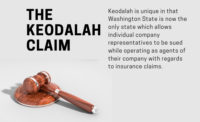Back to the Future: How Restorers Can Keep It Simple in 2022
The Intentional Restorer

If you travel back in time to February 2016, you will find the first published article by The Intentional Restorer in the annals of Restoration & Remediation. I submitted a piece about our internal experiment with shared office space. I expected to be rejected, but was pleasantly surprised when the article was posted and the feedback was positive. The question I asked all those years ago was, “Could restoration companies benefit from a non-traditional workplace?”
For reference, in our industry, it was commonplace to have the crew out in the warehouse in some ram-shamble “breakroom” and operations such as project managers in haphazard cubicles. Meanwhile, the important staff, the estimators, had secluded offices with air conditioning. Here we are on the brink of 2022, with resources at the ready to make in-house estimators all but obsolete, and not much has changed in the status quo dynamics of the average restoration company. I was a renegade in my own office and yet I am one of two still directly working on this “side” of the industry from the management team I was a part of at the time.
If you have read my articles, you will know that the content isn’t anything exceptional. As one recent viewer of The DYOJO YouTube channel summarized, “Annoying but helpful.” Science teaches us that matter is neither created nor destroyed, and it should be no surprise ideas are bound by the same laws. Most of what is shared on the socials is recycled or borrowed from others, even the edgy stuff. The recent packaging of ideas is often referred to as thought-leadership, even though most of the content is insufferably platitudinous with few remnants of either element for which is it marketed.
The reach of the interwebs has reduced the obstacles to creating and releasing content designed to influence our mindset and habits about a variety of topics. Access to noise has increased. I believe that a simple resource for sifting through the chaff is understanding whether a concept is theoretical or has been tested in a real-world application that is similar to your own.
Anyone with content still has to traverse the hurdle of distribution, which requires the self-funded to be vigilant, if not annoying, to gain any social traction. In the aforementioned article, I had a thought, and as a person in a position of leadership, I had the means to put my theory to the test. Once in motion and showing the results that I posited, i.e. reduce organizational barriers and increase team engagement, I shared the outcome with my peers through R&R.
With the few keystrokes I have left through this particular medium, I would like to ask and attempt to answer a question that I think is key for everyday restorers. What can an intentional restorer do to access the best information possible? My thoughts as an average restorer are as follows:
- Your goal should be to shorten your DANG learning curve, not to replace it. Anyone who you perceive as knowing more than you has not reached their current status because they were better equipped than you; rather, they have experienced more than you and persevered to that point. As the speed of change increases, it is all the more critical for intentional restorers to understand why they are where they are, as opposed to just gloating or commiserating about their current position. For example, a company that is experiencing success with no comprehension of how they got there is often in a more tenuous position than a team that is struggling but has a clear understanding of its next steps. The journey is as important as the destination.
- KISS is not only an iconic band but is about as sound of a principle as you can apply to your personal and/or professional growth. Keep It Simple Stupid is a great metric for designing your plan for next year as well as a wonderful tool for weeding out the BS that is prevalent in the platitudes disguised as growth hacks rumbling through the ether. You do not struggle for a lack of information, but you will continue to deteriorate in the gaps of application. This does not mean that you stop learning. If you could increase your engagement and commitment to 25% of what you already know, you would accelerate your ability to gain ground on your goals (after you strip away the nonsense ones that you heard in the mist).
This is my last article as a monthly column in R&R. For the 13 people that this will affect, it is not for any lack of respect for the publication or trust that Valerie will continue to kick butt and grow the platform. I too struggle with KISS and this decision is a necessary one for 2022. In my opinion, being an intentional restorer has nothing to do with being the best. You and I are only in competition with ourselves because you and I are also our biggest barriers to “success”. This probably applies more to me than you. But, for the items listed above:
- If you can cut the noise...
- Shorten your DANG learning curve...
- Apply a fraction of what you already know...
- Resist the urge to make things more complicated than they should be...
...You will have a fighting chance at being competitive this coming year and those that follow.
- Shut up and think.
- Lead yourself first.
- Then, and only then, lead others by example.
It’s pretty amazing what a few committed, average people can do when they have some clarity, consistency, and accountability to each other. If the Jon from five years ago has anything further to add, perhaps this idea still has merit: “Your office is your second home. Arguably, you spend more time in your workspace with your work peeps than with your actual family, so making it an enjoyable and functional environment should be a priority.” While many babbling bobble heads will ramble on and on about the complications of talent *retention, perhaps many of the answers are simpler than we make them out to be?
(* This is actually a slight of tongue. If you listen to what many influencers speak about, it’s talent acquisition rather than retention. The latter has greater ROI in my not-so-humble opinion.)
Looking for a reprint of this article?
From high-res PDFs to custom plaques, order your copy today!






